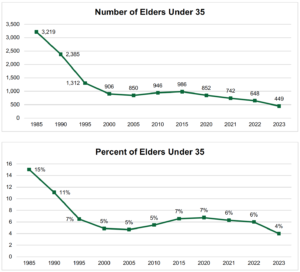![]()
 Download the 2023 Clergy Age Trends Report.
Download the 2023 Clergy Age Trends Report.
Highlights of the 2023 Report
Young Elders Reach New Record Low Number
The recent decline in the number of young elders (under 35) began in 2017 and followed modest gains after the low point of 2005. That decline continues; however, the scale of the decline increased dramatically beginning in 2019. Since 2019, there has been a decline of 53 percent in the number of under-35 elders. The losses were comparable for men and women based on the proportion of each among young elders. The number of young elders in 2023 is 449, a loss of 199 in the past year. This year sets a new record for the fewest young elders.
In addition to the overall number of active elders continuing to decline in 2023, young elders constitute 4 percent of active elders in 2023, down from 6 percent in 2022.
Some Increased Presence of Middle Age Elders
Beginning in 2000, we saw a trend of fewer elders in the middle age (35-54) group and more elders in the older (55-72) group. Despite a mandatory retirement age of 72, with most retiring before that age, the pool of older elders continued to grow for twenty years. In 2020, a modest turn in this trend began that continues in 2023. The middle age group as a proportion of all elders increased by three percent in 2023 (from 41 to 44 percent), with a one percent decrease for the older group’s proportion (to 52 percent) plus the two percent decline for young elders. Keep in mind that all age groups of elders declined in raw numbers, but some declined more than others, thus the change in proportional representation.
Young Deacons Also Decrease
There is a decrease in young local pastors in 2023 to 416 compared to 561 in 2022. There was also a decline in the percentage of young local pastors as a percentage of all local pastors to 7 percent from 8 percent last year. There are proportionately more young local pastors than young elders but fewer than young deacons. Elders and local pastors are appointed as pastors of congregations. In 1990, there were over five elders for each local pastor; today there are 1.6 elders for each local pastor. The proportions of local pastors compared to elders remained the same in 2023 after many years of local pastors showing increased representation and elders decreased representation. While elders and deacons are seeing some declines in the previous rising rates of older clergy from 55 to 72 years of age, this is not true for local pastors where 58 percent of all local pastors are in this oldest cohort.
Local Pastor Numbers Decline, Including Young Local Pastors
There is a decrease in young local pastors in 2023 to 416 compared to 561 in 2022. There was also a decline in the percentage of young local pastors as a percentage of all local pastors to 7 percent from 8 percent last year. There are proportionately more young local pastors than young elders but fewer than young deacons. Elders and local pastors are appointed as pastors of congregations. In 1990, there were over five elders for each local pastor; today there are 1.6 elders for each local pastor. The proportions of local pastors compared to elders remained the same in 2023 after many years of local pastors showing increased representation and elders decreased representation. While elders and deacons are seeing some declines in the previous rising rates of older clergy from 55 to 72 years of age, this is not true for local pastors where 58 percent of all local pastors are in this oldest cohort.
![]()
 Download the 2023 Clergy Age Trends Report.
Download the 2023 Clergy Age Trends Report.
Previous Clergy Age Trends Reports
![]() 2022 | 2021 | 2020 | 2019 | 2018 | 2017 | 2016 | 2015 | 2014 | 2013 | 2012 | 2011 | 2010 | 2009 | 2008 | 2007 | 2006
2022 | 2021 | 2020 | 2019 | 2018 | 2017 | 2016 | 2015 | 2014 | 2013 | 2012 | 2011 | 2010 | 2009 | 2008 | 2007 | 2006





